
Top 7 Website Visitor Identification Software for 2025
B2B Website visitor identification software is essential for every marketing company and business to have close access and reachability to their customers and visitors, especially with the ever-changing market dynamics. This enables them to turn every inquiry into an opportunity to make better sales and conversions. This blog will help you learn how to make personalized approaches to turn inquiries into leads and eventually into successful conversions with the help of the top 7 website visitor identification software tools enlisted in this blog.
B2B Website visitor identification software is essential for every marketing company and business to have close access and reachability to their customers and visitors, especially with the ever-changing market dynamics. This enables them to turn every inquiry into an opportunity to make better sales and conversions. This blog will help you learn how to make personalized approaches to turn inquiries into leads and eventually into successful conversions with the help of the top 7 B2B website visitor identification software enlisted in this blog.
A B2B business needs to be vigilant about the people visiting its website to turn the traffic into meaningful leads and sales. The availability of ‘Website Visitor Identification Software’ has turned the game for businesses and has enhanced the scope of scoring quality leads, sales, and conversions.
Although this task might seem next to impossible if approached manually, there are some dedicated and specified tools and software that make it seamlessly effortless and accessible. These organizations have developed their product to keep track of website visitors and fetch relevant information about them. This level of alertness and accessibility is requisite for earning new customers in the industry while retaining the existing ones.
This blog will help you gain a clear understanding of the know-how related to visitor identification software. It will also list the top seven B2B website visitor identification software to help you choose the right tool that aligns with your business’s nature or requirements.
What Is Website Visitor Identification Software?
With the escalating prevalence of data security and user-data encryption, it has become challenging for marketing and advertising personnel to fetch individualized information about website visitors. This makes it tough for companies to enforce targeted campaigns, emails, and other data-driven marketing efforts.
In this situation, B2B website visitor tracking and identification software plays a significant role in dealing with this problem With the help of advanced AI and ML implementations, these tools and software help companies acquire crucial information, including the name, email ID, phone number, location, and customer journey of every visitor, with minimal manual work and involvement.
Simply put, they take the anonymity of the website traffic away by providing tractable and useful data about the people clicking on a business’s website. This critical service and information attainability helps the business to understand its intended customers while reaching out to them with personalized approaches and solutions.
Why Do Businesses Need Website Visitor Identification Software?
There are various advantages that a business could leverage by using competent and reliable website visitor identification software. Some of the prominent benefits offered by these tools include:
- Enables cross-device tracking
- Helps focus on rendering a personalized user experience
- Unbound escalation in sales and conversions through visitor information
- Targeted follow-up, email marketing, and engagement efforts
- It helps you stay ahead of the curve
These tools enable a business to conduct cross-device tracking, which has become difficult and obstructed due to amplified privacy and data security structures. You can reach a customer through targeted or personalized approaches across various devices and channels.
According to studies, personalization increases the chances of conversion by 40%. A website visitor identification software makes such figures easily achievable by helping a business make personalized campaigns and marketing strategies to gain the attention and confidence of a targeted customer base.
As a result of the impact and outstanding functionality of visitor identification software, a business can experience an unprecedented increase in its sales and customer base. The accessibility to detailed visitor information and user data helps an organization influence, convince, and convert customers through data-driven and personalized approaches.
As discussed earlier, B2B website visitor identification software offers accessibility to individual user data. This makes it possible for businesses to make follow-up approaches through email, targeted ads, and other mediums. These endeavors focus on retaining customer engagement and leading the customer journey toward successful conversion.
The personalized and targeted approaches made attainable by website visitor tracking software will eventually help you take a competitive advantage and stay ahead of the curve. Elaborate strategies and approaches help boost conversions and transform leads into sales with an unbelievable strike rate.
Pro Tip- Use one of the tools mentioned above to make your website, content, CTAs, and emails more tailored and personalized for the visitors. It will help you increase engagement and conversions significantly.
Key Tools and Technologies for Visitor Identification
Unraveling the intricacies of website visitor identification requires a robust set of tools and technologies designed to capture valuable user data. Below, we delve into essential software solutions and methods that empower businesses to recognize and analyze their website visitors, laying a foundation for enhanced user experiences and strategic marketing initiatives.
Overview of the Website Visitor Identification Software Landscape
The website visitor tracking software landscape is marked by diverse tools that serve distinct purposes, from tracking user interactions to personalizing content. These tools give businesses the insights to tailor their approach to individual users and broader segments, fostering improved engagement and conversion rates.
Advantages of Utilizing Various Identification Tools
Employing a multifaceted suite of identification tools can yield a multitude of advantages. It allows a more accurate understanding of visitor demographics, behaviors, and preferences. Moreover, these tools facilitate the creation of targeted marketing campaigns that resonate with the audience, driving customer acquisition and retention.
Cookies and Tracking Technologies
- Explaining the role of cookies in tracking user activities:
- Different types of cookies and their purposes in visitor identification:
- Privacy considerations and user consent:
Cookies are instrumental in gathering information about website visitors. They help create a more personalized browsing experience by remembering user preferences, login details, and browsing history.
Session cookies, persistent cookies, and third-party cookies each play a critical role in capturing diverse data points that inform user-profiles and behaviors on a website.
The use of cookies intersects with privacy regulations. Businesses must secure user consent before tracking their activities, ensuring compliance with laws like GDPR and fostering trust with their audience.
IP Address Identification
IP addresses are key to recognizing visitors’ geographical locations and segmenting audiences. This enables companies to segment their audience and tailor content based on regional preferences and requirements.
Limitations of IP-based identification: While beneficial, relying solely on IP addresses can result in inaccuracies due to shared networks and privacy-conscious users’ increasing use of VPNs, which can obscure true locations.
Pro Tip- Combine IP address identification with other tracking methods like cookies and user identifiers to enhance accuracy and gain deeper insights into visitor behavior, ensuring a more comprehensive understanding of your audience.
Leveraging Conversion Rate Optimization (CRO) Techniques
Conversion Rate Optimization (CRO) is an essential strategy for turning visitors into customers. By understanding the complex relationship between visitor identification and CRO, businesses can craft targeted approaches that directly influence the decision-making process of their audience.
The Relationship Between Visitor Identification and CRO
Effective CRO begins with comprehensive visitor identification. By accurately identifying who is coming to your site – what pages they visit, what devices they use, and what actions they take – you set the stage for sophisticated CRO strategies. Visitor identification allows for personalized experiences, which can significantly improve conversion rates. Essentially, the more you know about your visitors, the better you can tailor your content and calls to action to match their needs and desires.
Strategies for Using Visitor Information to Drive Conversions
Visitor information is a goldmine of insights that can lead to higher conversion rates. Here are several strategies to utilize this data effectively:
- Personalization:
- Segmentation:
- Behavioral Triggers:
- A/B Testing:
- Optimization of Call-to-Actions (CTAs):
Customize user experiences based on browsing behavior, traffic source, and historical data to enhance relevance and engagement.
Divide your audience into segments based on their characteristics and behaviors and target them with specific messages.
Implement automated actions that react to user behaviors, such as offering a chat support window if a visitor spends an unusual amount of time on a checkout page.
Use A/B testing to find the most effective version of your web pages and refine it based on the performance of each variant.
Analyze visitor data to create compelling CTAs that increase user engagement and conversions.
By adopting these CRO techniques and leveraging detailed visitor information, businesses can create a more compelling, user-centric website that actively converts visitors into leads and customers.
Pro Tip- Continuously monitor and analyze visitor data to iteratively refine your CRO strategies. By regularly evaluating user behavior and testing different approaches, you can uncover new opportunities for optimization and consistently improve conversion rates over time.
Maximizing Engagement with Email-Based Identification Tools
The utility of email as a vehicle for website visitor identification is undisputed in digital marketing. Email-based identification tools unlock the potential to transform anonymous website visits into actionable data, providing an opportunity for personalized marketing strategies tailored to the interests and behaviors of individual users.
The Effectiveness of Email as an Identification Mechanism
Email is a unique identifier for online users, offering a consistent point of reference as consumers navigate the digital landscape. This makes it especially powerful for tracking user interactions and mapping them back to a specific individual’s preferences and history with your brand.
- Personalization:
- Data Enrichment:
- Customer Journey Mapping:
By recognizing an individual through their email, businesses can curate content, offers, and experiences that resonate on a personal level.
Accumulating data tied to an email address allows for a richer understanding of user nuances, driving more sophisticated marketing efforts.
Email identification provides insights into the customer journey, enabling the delivery of timely, relevant messaging.
Integrating Email Campaigns with Visitor Identification for Personalized Marketing Experiences
Integrating email campaigns with visitor identification software creates a seamless experience for marketers and consumers. As users engage with your email campaigns, their interactions with your website can be tracked and tied back to their email addresses, facilitating a level of personalization that was previously out of reach.
- Behavioral Targeting:
- Segmentation:
- Retargeting:
Track which links a user clicks within an email and presents related content or follow-ups that complement their interests.
Use email interactions to segment users and tailor website content to different audience groups based on their engagement with your emails.
Capitalize on identifying visitors who did not convert by retargeting them with personalized email campaigns designed to bring them back.
The strategic use of email-based identification tools refines the alignment between website content and user expectations, enhancing the overall experience and driving conversion. When leveraged correctly, the synergy between email marketing and website visitor identification can significantly elevate your brand’s digital presence.
Pro Tip- Implement double opt-in processes for email identification to ensure data accuracy and compliance with regulations like GDPR. This enhances trust with users and ensures that your marketing efforts reach an engaged audience genuinely interested in your brand.
Advancing Lead Generation and Enrichment
As businesses aim to remain competitive in a rapidly evolving digital landscape, understanding the nuances of website visitor identification software is crucial for optimizing lead generation and enrichment processes. The strategic collection and application of visitor information boosts lead quality and informs more effective sales strategies.
Collecting and Using Visitor Info for Lead Generation Purposes
Gathering detailed insights about the individuals visiting your website is the cornerstone of any successful lead generation strategy. Businesses can convert anonymous traffic into identifiable prospects using website visitor identification software. This information goes beyond mere numbers and statistics; it provides valuable context, such as the visitors’ industries, their interests based on pages visited, and their position in the buying cycle, allowing for targeted follow-up actions.
Tools and Methods for Enriching Collected Data to Inform Sales Strategies
Once the initial data is collected, the enrichment process is paramount. This involves adding layers of information to each lead to ensure the sales team has a comprehensive view of potential customers. With advanced tools at your disposal, you can:
- Integrate lead information with already existing data in your CRM, enhancing the full profile of your prospects.
- Utilize lead scoring models to prioritize and segment prospects based on their engagement and conversion likelihood.
- Incorporate artificial intelligence and machine learning algorithms to predict future customer behavior and preferences.
In conclusion, website visitor identification software is not just about recognizing who’s on your site – it’s a tool for enriching the lead generation process, offering a more tailored approach to your interactions with potential buyers, and fueling a more informed and efficient sales pipeline.
Pro Tip- Regularly review and update your lead enrichment processes to adapt to changing market dynamics and customer preferences. By staying agile and incorporating new data sources and technologies, you can ensure that your sales strategies remain effective and relevant in generating high-quality leads.
Maximize Your Marketing Efforts with Seamless Integration
In today’s digital landscape, integration and installation of website visitor identification software with marketing automation platforms is crucial for streamlining processes and optimizing marketing strategies. Such synchronization enables businesses to harvest the full potential of their visitor data, turning anonymous browsers into valuable leads.
Unleashing the Power of Integration
Integration goes beyond mere convenience- it’s about enhancing the functionality of both systems to provide a unified approach to your marketing efforts. By aligning visitor identification with your marketing automation, your team can benefit from a smoother workflow and a more cohesive strategy.
- Real-Time Data Sharing:
- Advanced Lead Nurturing:
- Accurate Lead Scoring:
Synchronize visitor activities and behavior with your marketing automation system for instant insights and action.
Use enriched visitor data to tailor and automate personalized lead nurturing campaigns that resonate with each user’s interests and needs.
Improve your lead scoring mechanisms by incorporating detailed visitor engagement metrics, leading to better qualification and prioritization of prospects.
Integrating your
Pro Tip- Choose website visitor identification software and marketing automation platforms that seamlessly integrate via APIs for real-time data sharing. This ensures a unified marketing approach, enabling personalized campaigns and accurate lead scoring, maximizing conversion rates and efficiency.
Challenges and Opportunities in Cross-Device Tracking and Identification
As the digital landscape evolves, businesses face the daunting task of reliably tracking user activity across many devices. Cross-device tracking is essential for creating cohesive user experiences and delivering personalized content. However, this endeavor poses unique complexities.
The complexity of tracking users across multiple devices
Establishing a singular user identity is challenging, with consumers frequently switching between smartphones, tablets, and desktops. Not only must software discern user behavior patterns, but it must also accurately link these behaviors to the same individual despite the use of different devices.
- Privacy concerns:
- Technical limitations:
- Fragmented journeys:
Each device carries unique identifiers; balancing robust tracking with user privacy is more critical than ever.
Different operating systems and browsers complicate the analytics tracking process, as they may not always communicate seamlessly with one another.
Piecing together a user’s path through their multiple touchpoints requires sophisticated, integrated solutions.
Solutions and approaches for achieving accurate cross-device identification
Innovative solutions and approaches have emerged amid these challenges, offering new opportunities to capture and connect user data across devices.
- Deterministic tracking:
- Probabilistic tracking:
- Hybrid methods:
This method uses known identifiers, such as login information, to directly match the user across devices.
This approach employs algorithms to infer identities. It analyzes patterns like location, device type, and activities to predict user connections.
Combining deterministic and probabilistic techniques can leverage both strengths to improve accuracy in user identification.
By surmounting the obstacles inherent to cross-device tracking, businesses can unlock a deeper understanding of user behavior, streamline the customer experience, and ultimately drive conversions with targeted meaningful interactions. Successfully applying website visitor identification software capable of cross-device tracking represents a significant advantage in today’s competitive digital marketplace.
Pro Tip- Prioritize transparency and user consent in cross-device tracking initiatives to build trust and mitigate privacy concerns. Communicate your data collection practices and offer users control over their preferences to foster positive relationships and compliance with regulations.
Driving Decisions through Business Intelligence and Analytics
Website visitor identification software transcends the boundaries of mere data collection, entering into business intelligence and analytics. These advanced technologies play a pivotal role in interpreting visitor data and are integral in transforming raw information into meaningful insights. By understanding user behaviors and patterns, businesses can dive deep into analytic findings to inform and shape their strategic decision-making processes.
The Pivotal Role of Analytics in Interpreting Visitor Data
As digital footprints grow exponentially, businesses must leverage the power of analytics to dissect high volumes of data. Website visitor identification software equipped with robust analytics capabilities enables organizations to identify patterns and trends within their audience, giving them the clarity needed to optimize user experiences and streamline conversion funnels.
Turning Insights into Actionable Business Strategies
It’s not enough to collect data – the true work and power lies in converting insights into actionable business strategies. Through a meticulous analysis of visitor interactions, companies can craft targeted campaigns, personalize user engagement, and deploy resources more efficiently. This strategic application of insights directly impacts the bottom line by boosting conversion rates and enhancing customer loyalty.
- Effectively using gathered data to forecast market trends and customer needs.
- Customizing user experiences to increase relevance and engagement.
- Identifying friction points within the website to improve conversion paths.
- Optimizing marketing tactics in line with visitor behavior to maximize ROI.
Flourishing in today’s data-driven landscape demands businesses collect visitor information and, more importantly, leverage analytical tools within visitor identification software to drive informed business decisions. By embracing business intelligence and analytics, companies set the stage for sustained growth and competitive advantage.
Pro Tip- Continuously refine and iterate your analytics strategy to extract actionable insights that drive tangible business outcomes. Focus on identifying key metrics aligned with your business goals, and leverage sophisticated analytical tools within your website visitor identification software to uncover trends, optimize user experiences, and maximize ROI.
What Are The Top 7 B2B Website Visitor Identification Software?
After reviewing the characteristics and benefits of visitor identification software, it is time to select the seven best software programs extensively used by businesses and offering limitless potential and functionalities.
- DiGGrowth
- Visitor identification
- Deanonymization
- Profile and account analytics
- Multi-touch attribution
- Integrations
- Campaign Tracking
- Marketing attribution, etc.
- Salesforce
- Google Ads
- Hubspot
- Marketo
- Facebook Ads, and more.
- Website Visit Tracking
- Email Tracking and Templates
- Call Tracking and CPQ Capabilities
- Robust Analytics for Data-Driven Sales Decisions
- Integration Within the HubSpot CRM Ecosystem
- Factors
- Automatic CRM synchronization
- Detailed visitor insight
- Visitor identification
- User-first website design
- Clearbit
- Leadsquared
- 6Sense
- Rudderstack
- Bing Ads
- Segment, etc.
- Clearbit
- Enrichment through a database with over 250 data sources
- Deanonymization through Reveal
- Automatic contact information integration through Capture/li>
- Marketo
- Segment
- Slack
- Salesforce
- Leadfeeder
- Qualifying high-potential leads according to their web activity.
- Leadfeeder contacts to determine the best individual to connect with from the targeted business’s hierarchy.
- Automatic integration of CRM with other tools and platforms
- Pipedrive
- Zapier
- Slack
- Salesforce
- Lead Forensics
- Visitor identification
- Deep visitor insight
- Mobile App
- Zoho
- Square
- Mailchimp
- Salesforce
- Visitor Queue
- An intuitive user-first design
- Website personalization option
- Lead intelligence with web activity insights
- Slack
- Zapier
- Hubspot
- Salesforce
- Albacross
- Analytics enrichment through measured KPI metrics
- Personalization enrichment through email, web content, and ad campaigns
- Detailed insights into user behavior
- Google Analytics
- Hubspot
- Slack
- Pipedrive
DiGGrowth is one of the leading website visitor identification software out there that helps marketers with their marketing analytics and attribution operations. It also streamlines the website monitoring functions for B2B companies and helps them discover, reach, and convert the companies or visitors into successful leads and customers. Moreover, DiGGrowth also keeps track of account-level website behavior and customer journey.

Features offered by DiGGrowth-
It can be effortlessly integrated with other analytical tools and software. Such as,
HubSpot
Integrating HubSpot into your website visitor identification strategy can significantly enhance your marketing and sales efforts. Here are some key features of HubSpot’s capabilities:
Key Features
By leveraging HubSpot’s suite of tools, businesses can gain deeper insights into their website visitors, tailor their marketing approaches, and ultimately drive more effective engagement and conversions.
It is an AI-based account and website visitor identification software that efficiently helps businesses identify potential customers or businesses that they could successfully onboard as customers. It successfully monitors the efficiency of website content in bringing leads and conversions. It also helps identify the campaigns that are bringing in qualified leads.
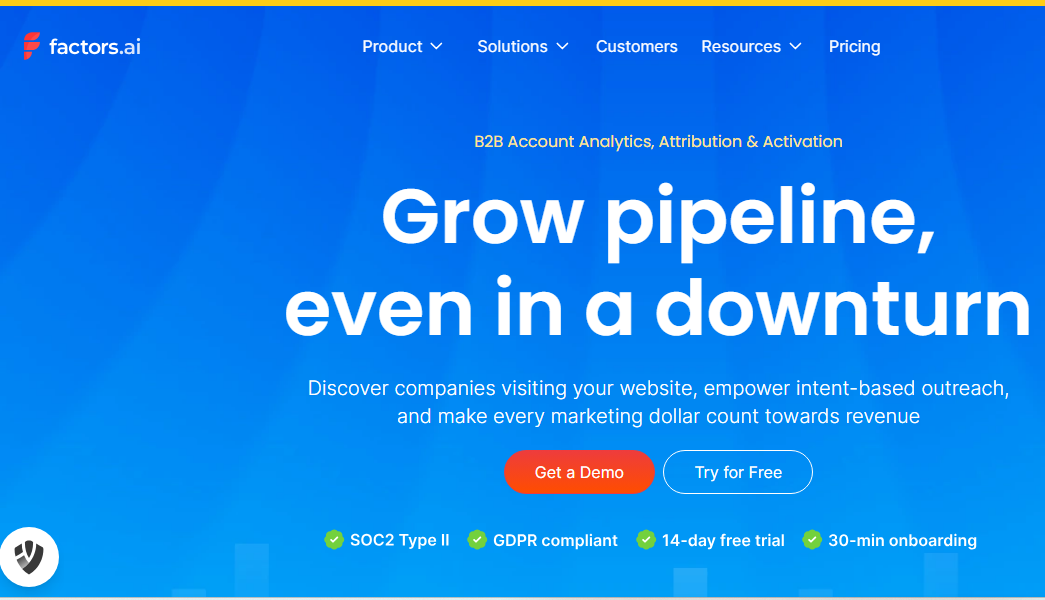
Features offered by Factors-
Factors can be integrated with the following tools and platforms:
Clearbit is a prominent B2B interaction platform that helps B2B companies utilize their CRM data, identify, understand, and have personalized interactions with their prospect customers.
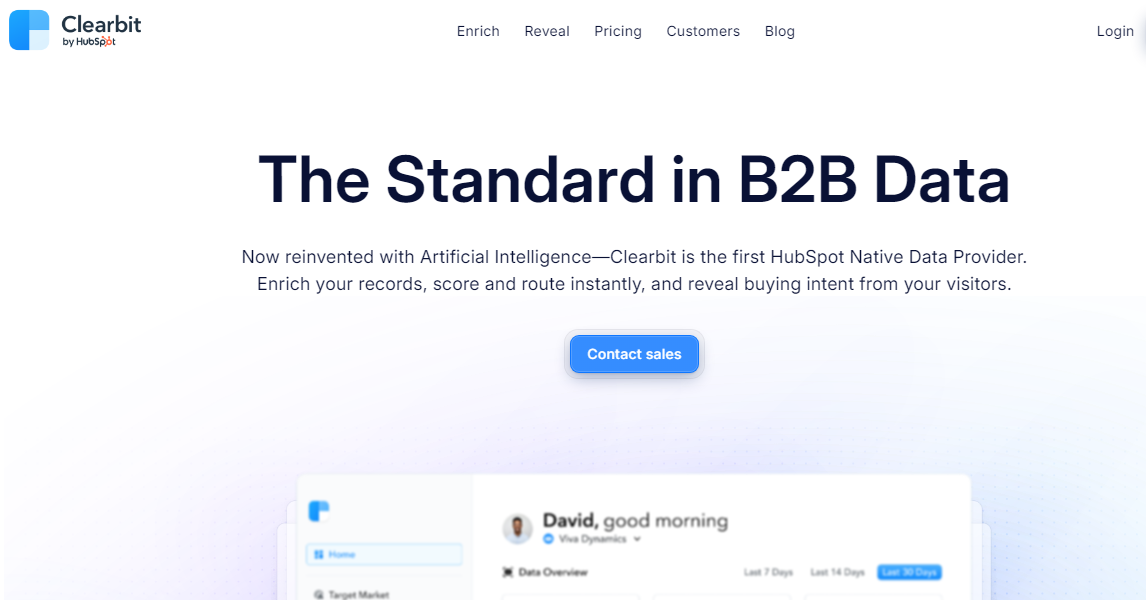
Features offered by Clearbit:
It can be used in integration with the following platforms:
Leadfeeder is a prominent website visitor identification software that helps B2B businesses identify and connect with visitors or businesses visiting their websites. It also helps the targeted customers connect with the deciding members of the targeted companies.
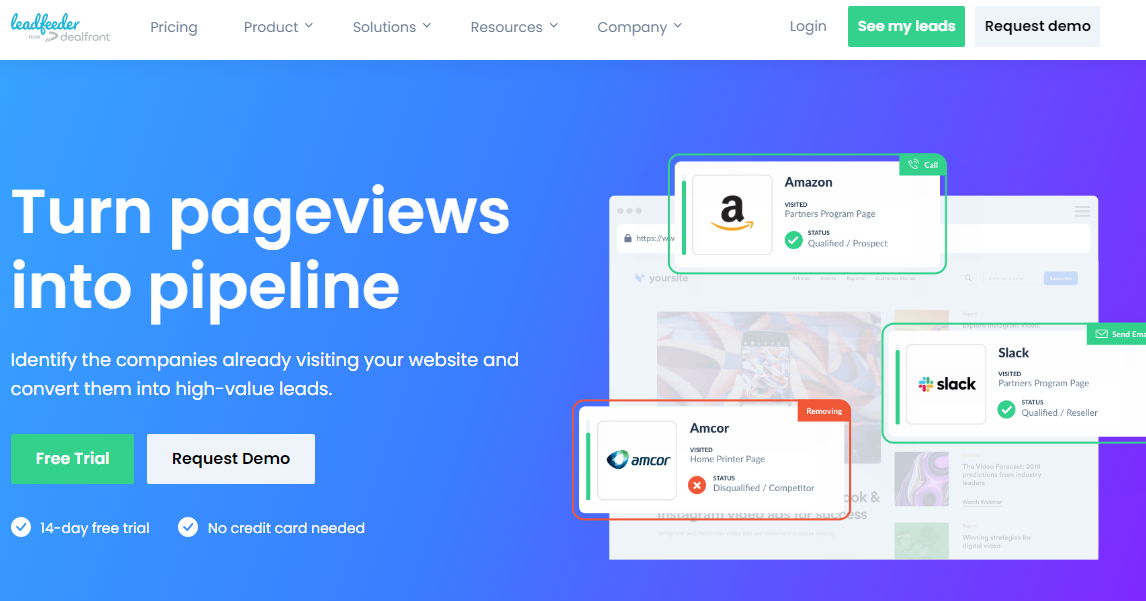
Features offered by Leadfeeder:
Leadfeeder accessibly integrates with the following tools and software:
Lead Forensics is another leading visitor identification software, greatly loved by businesses and marketers. It helps businesses identify and learn about website visitors. Moreover, it helps in understanding and analyzing prospective customers’ web-behavior.
Features offered by Lead Forensics include:
It seamlessly integrates with the following software:
Visitor Queue is a popular tool that helps identify website visitors in real-time. It also allows businesses to customize their websites to give visitors and customers a personalized user experience.
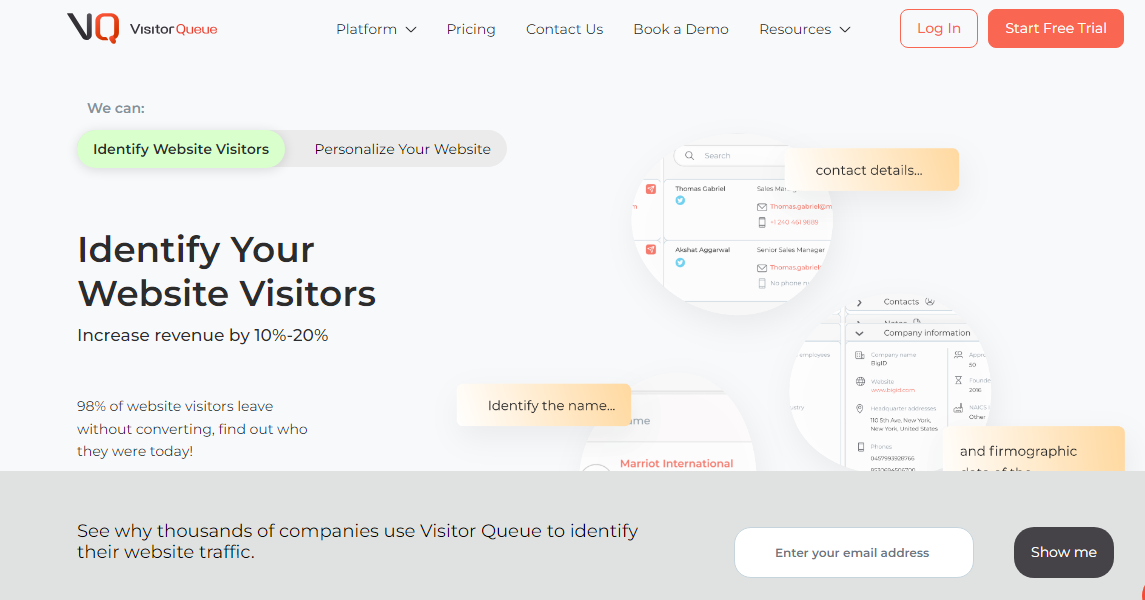
It can be integrated with the following platforms:
Albacross is also a premium website visitor identification software that enables B2B businesses to identify anonymous website visitors and get valuable insights and information about them. These insights help businesses make personalized data-driven approaches and efforts, leading to successful lead conversion.
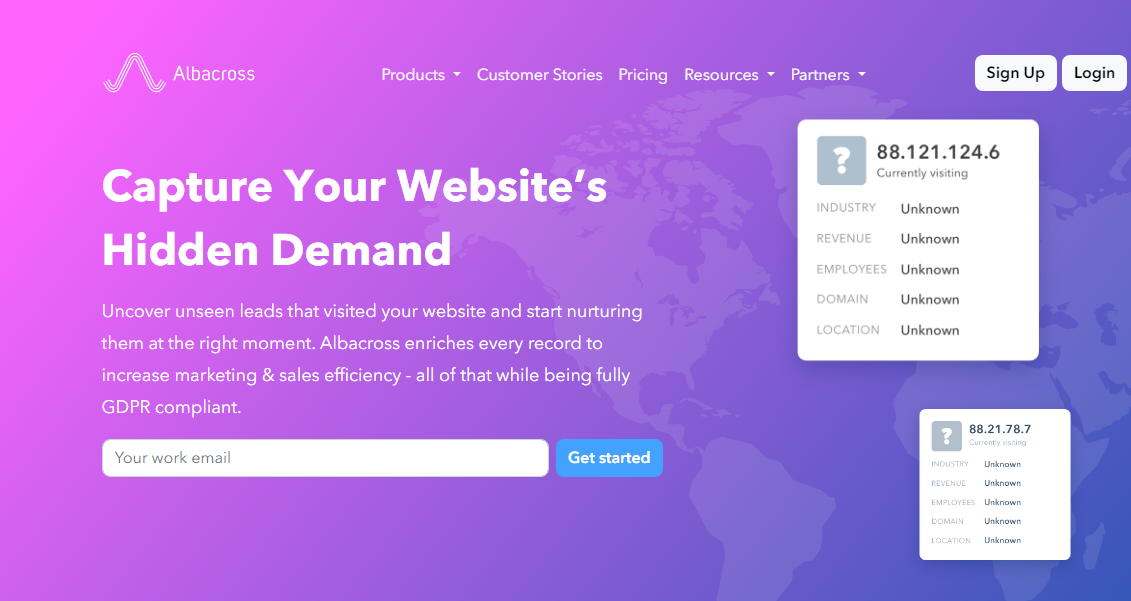
Features offered by Ablacross:
It can be integrated with the following platforms:
DiGGrowth and all the other platforms are equally efficient for extending personalized approaches to connect with website visitors.
Key Takeaways
- Visitor identification provides an edge and additional efficiency to a business’s marketing efforts.
- It also amplifies the conversion capabilities of a B2B business.
- Some of the most relevant website visitor identification tools are listed in this blog.
Conclusion!
This blog helps you expand the scope of your understanding and capability for identifying the website visitors who can be converted into valuable leads and conversions. You can choose any of the given visitor identification tools according to your unique business requirements and adaptability.
Website visitor identification software has become an indispensable tool in modern businesses looking to understand and leverage user behavior for enhanced engagement, lead generation, and conversion optimization. By recognizing the digital footprints of your visitors, companies can sharpen their marketing strategies and drive growth with data-driven insights.
The digital marketing landscape is ever-changing, and so must our tools and techniques. Integrating website visitor identification software into your growth strategy is smart and necessary in an increasingly digital world. Equipping your business with these solutions allows for a deeper connection with your audience, fostering opportunities for conversion and beyond.
Still confused? Use DiGGrowth as your ideal visitor identification software. Talk to Us!
Write to us at info@diggrowth.com and we’ll get back to you.
Citations
https://www.factors.ai/
https://clearbit.com/
https://www.leadfeeder.com/
https://www.leadforensics.com/
https://www.visitorqueue.com/
https://albacross.com/
Ready to get started?
Increase your marketing ROI by 30% with custom dashboards & reports that present a clear picture of marketing effectiveness
Start Free Trial
Experience Premium Marketing Analytics At Budget-Friendly Pricing.

Learn how you can accurately measure return on marketing investment.
Additional Resources
Don’t Let AI Break Your Brand: What Every CMO Should Know
AI isn’t just another marketing tool. It’s changing...
Read full post postFrom Demos to Deployment: Why MCP Is the Foundation of Agentic AI
A quiet revolution is unfolding in AI. And...
Read full post postAnswer Engine Optimization (AEO): The New Frontier of SEO in 2025
As digital experiences continue to evolve, so does...
Read full post postFAQ's
Implement tools like Google Analytics to track visitors' demographics, behavior, and interests.
Use forms, surveys, cookies, and tracking pixels to gather information such as email addresses, preferences, and browsing habits.
Optimize for search engines, create engaging content, utilize social media, advertise through PPC campaigns, and collaborate with influencers to drive traffic.
Employ IP tracking, cookies, and user identifiers to gather insights on anonymous visitors' behavior and preferences. Additionally, offer incentives for visitors to provide their contact information for future engagement.
An SEO dashboard is a centralized tool that tracks and visualizes key SEO metrics such as organic traffic, keyword rankings, backlinks, and technical SEO performance. It helps marketers monitor search visibility and optimize their strategies effectively.
An SEO dashboard provides real-time insights into website performance, enabling data-driven decisions. It consolidates multiple data sources into a single view, improving efficiency and tracking progress toward SEO goals. Identifying opportunities and issues, helps businesses enhance their search presence.
Selecting the right SEO dashboard depends on its ability to track rankings, traffic, backlinks, and site health. The tool should integrate seamlessly with platforms like Google Analytics and Search Console while offering customization and automated reporting. Popular choices include DiGGrowth, Google Looker Studio, SEMrush, Ahrefs, and Moz Pro.
SEO dashboards connect with Google Analytics and Search Console for keyword insights and traffic data. They integrate with CRM systems like HubSpot and Salesforce to track SEO-driven leads, while marketing automation tools like Marketo and Mailchimp align SEO efforts with content marketing. Additionally, they help compare organic and paid search performance by linking with PPC platforms such as Google Ads.
 Richa Bhardwaj
Richa Bhardwaj  Sameer Pawar
Sameer Pawar 

